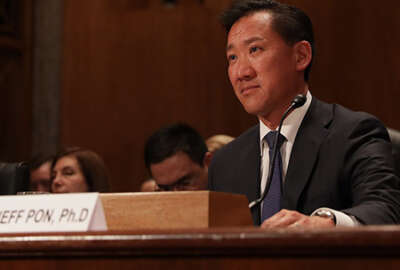
Agencies beginning to restore official time, office space, but EO’s impacts still linger
Agencies are beginning to revoke the actions they previously took to comply with the president's recent workforce executive orders, federal unions said.
Best listening experience is on Chrome, Firefox or Safari. Subscribe to Federal Drive’s daily audio interviews on Apple Podcasts or PodcastOne.
Agencies are beginning to give word on how exactly they plan to revoke the actions they took earlier this summer to comply with the president’s executive orders on official time, collective bargaining and employee removals.
Since the Office of Personnel Management announced last week the administration would “fully comply” with the U.S. District Court Judge Ketjani Brown Jackson’s decision to invalidate nine key provisions of the president’s executive orders, agencies are informing union representatives of their plans to restore official time and open up federal office space, among other actions.
The IRS Office of Chief Counsel has told the National Treasury Employees Union that it intends to pull back from its initial plans to limit official time for union representatives, NTEU said Tuesday.
The Social Security Administration informed the American Federation of Government Employees (AFGE) last Thursday that it has restored official time, union office space and use of SSA computers, phones and IT systems, Witold Skwierczynski, former president and now adviser for AFGE’s National Council of Social Security Administration Field Operations Locals (Council 220), told Federal News Radio.
In addition, SSA has told AFGE it will stop performance-based removals after a 30-day performance improvement period, and the union will be allowed to use official time to prepare employee removal grievances.
Both parties still need to negotiate a formal system for union representatives to submit claims for the lost time, travel and other expenses they incurred during the implementation of the executive orders, Skwierczynski said.
Skwierczynski retired from SSA earlier this summer and cited the EOs as the main reason for his decision. He said he didn’t run for re-election but still works for the AFGE council and is paid some salary for his work.
SSA was one of the first agencies to inform union representatives of its plan for implementing the president’s EOs back in late June, and it gave AFGE until July 31 to vacate agency property.
Skwierczynski said SSA acknowledged the “easy parts” in restoring office space and official time since the court’s decision. The AFGE local at SSA headquarters in Baltimore, Maryland, had moved the equipment it owned, including 70 file cabinets and other records, into a storage unit.
But the union isn’t immediately moving back into the headquarters space yet, because contract negotiations between SSA and AFGE are still tense and uncertain, Skwierczynski said.
SSA has proposed to eliminate 17 previously-agreed-to articles from its contract with AFGE, Skwierczynski said. After both parties couldn’t agree during negotiations this summer, SSA sought help from the Federal Services Impasse Panel, he said. AFGE has asked SSA to return to the bargaining table, and both parties have sessions planned for late September.
NTEU, which also represents about 1,700 employees at SSA’s Office of Hearing Operations, also said the agency has informed the union of its intention to comply with the court’s recent orders. Specific details haven’t been worked out yet, NTEU said.
Path forward for contract negotiations still unclear
But other, perhaps less concrete impacts from the president’s EOs, haven’t been resolved.
NTEU said the president’s EOs prompted the Health and Human Services Department to revive a series of collective bargaining negotiations for a new contract, which the union said had been stalled for more than two years.
HHS submitted bargaining proposals that didn’t include more than a dozen previously-agreed-to articles on disability accommodations, telework and transit subsides. NTEU submitted its own proposals, and the two parties met briefly this summer to discuss them.
HHS declared an impasse. NTEU wrote to the agency last week asking that HHS reopen bargaining negotiations in light of the federal district court’s decision on the president’s EOs.
NTEU said it hasn’t heard back yet from HHS.
The court’s decision is “proof positive that the bulldoze approach taken by HHS will not work,” NTEU National President Tony Reardon said Tuesday. “They must sit down with us and bargain a real agreement. NTEU is prepared to do that.”
In the mean time, House Oversight and Government Reform Committee Ranking Member Elijah Cummings (D-Md.) is looked for a more detailed update on how agencies are complying with the recent decision.
He wrote to Office of Management and Budget Director Mick Mulvaney and OPM Director Jeff Pon and asked for a briefing on what the Trump administration is doing to restore the status quo ante at agencies who had already implemented provisions of the executive orders before the federal district court’s most recent ruling.
“Some agencies were already actively implementing the policies the court struck down, and OPM’s tersely worded revision does not address what agencies should do about illegal actions that agencies have already taken to implement the invalidated sections of the executive orders,” Cummings wrote in an Aug. 31 letter.
Cummings also requested a timeline of OMB and OPM’s planned actions to bring agencies in line with the court’s recent decision and a sense of the administration’s next steps on this topic.
Both OPM in its guidance and the Justice Department in a statement following the court’s decision also said the administration was considering what next legal steps it may take.
Copyright © 2025 Federal News Network. All rights reserved. This website is not intended for users located within the European Economic Area.
Nicole Ogrysko is a reporter for Federal News Network focusing on the federal workforce and federal pay and benefits.
Follow @nogryskoWFED







